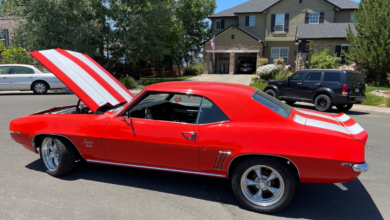Classic Muscle Cars: 1965 Shelby Mustang Gt350 Vs 1968 Chevrolet Corvette L88.
Among the many gems of the American muscle car era, the 1965 Shelby Mustang GT350 and the 1968 Chevrolet Corvette L88, were two of the very best.
In 1964, the Ford Mustang ‘pony’ car swept the United States, selling two million units in its first two years of production. Despite its athletic two-door design, most of its foundations came from more conventional Ford saloon vehicles, with the straight sixes being the most common engines. Carroll Shelby, the famed Le Mans 24 Hours winner and creator of the AC Cobra, updated the cars, painted in Wimbledon White with blue stripes and the sill panels. The Mustang GT-350 was equipped with a side-exiting exhaust system, upgraded brakes, suspension, and a spare wheel put where the rear seat should have been, making it suitable for sports car racing.
The L88’s story begins with Zora Arkus-Duntov’s entry to Chevrolet. Duntov was the first to persuade Chevrolet to include a manual transmission and a bigger engine in the Corvette, transforming the 1956 model into a true sports car. The L88 was initially given to teams like Sunray DX Motorsports, who competed with Corvettes in events like Sebring and Daytona. The L88 package, which was loaded with factory competition gear, was an ordering option that turned the Corvette into an actual race vehicle. Only 20 vehicles were built in 1967, primarily for racing, while approximately 200 L88s on the C3 chassis were ordered.
The Sharp Exterior Designs: 1965 Shelby Mustang GT350 Vs 1968 Chevrolet Corvette L88
The Shelby GT350 R was a purpose-built racer that formed the prototype for GT350 road cars to follow. It was painted with iconic Wimbledon white with blue stripes. Shelby made several modifications to the car in order to make it race-worthy. The body was altered significantly, including the addition of a unique fiberglass front apron. To fit 15×7-inch wheels, flares were built to the fenders. To replace the side and rear windows, the company also used Plexiglas with metal frames.
The Corvette L88 was one of the most unique-looking racing cars. The only external differences between the L88 and the normal C3 Stingray were the fantastic engine, a de-optioned interior, and the high-rise hood. However, the late 1960s were a golden era for Corvette design, and the L88 redesigned with the Vette’s distinctive shark shape with side gills, a sloping front end, bulging fenders, and broad rear haunches, made it one of the curviest and most sensuous automobiles of the age.
The Practical Interiors: 1965 Shelby Mustang GT350 Vs 1968 Chevrolet Corvette L88
Shelby fitted the GT350 with a new instrument cluster, including a tachometer and an oil pressure gauge. A 34-gallon gasoline tank and a huge 4-point roll cage were fitted. Other than that, the Mustang GT 350 was a standard Mustang on the inside. There is a steering wheel with a wood rim and a Cobra symbol on the hub. The front seats were Ford factory seats. Instead of the Brooks Brothers tie-with-a-buckle seat belts seen in most passenger automobiles, Air-Force seat belts were installed. Upfront, the passenger space was the same as any other Mustang, except that the steering wheel dish had pushed the wheel rim forward. The back passenger compartment was eliminated. The back seats were removed, and the space was filled with a molded fiberglass fitting that served as a level platform for mounting the spare tire.
L88’s minimal interior was finished in Saddle featured vinyl seats, crank windows, a manual transmission, and the usual three-spoke, thin-rimmed steering wheel. However, because it was designed specifically for racing, the L88 lacked a radio, air conditioning, power windows, tilt, and power steering wheel. The practical elements inside the L88, on the other hand, were a high-pile carpet, modest pieces of wood trim, and a full array of gauges.
The Beastly Engines: 1965 Shelby Mustang GT350 Vs 1968 Chevrolet Corvette L88
The 1965 Shelby Mustang was powered by a 289 cubic inch 4.7-liter water-cooled V8 cast iron block engine. The engine was equipped with a 10.5-inch single dry plate clutch and 4-speed, all-synchro 5 main bearings. The engine produced 306 HP at 6000 rpm and 329 lb-ft of torque at 4200 rpm. This engine returned 7-14 mpg fuel economy and 112–224 miles of range.
The L88 was distinguished by a complete racing kit that comprised a large block V8 engine with solid lifters and Can-Am-spec cylinder heads. The 430 horsepower 427 cubic inches 7.0-liter V8 was promised, although many believe production vehicles had upwards of 550 horsepower when they left the factory. A heavy-duty four-speed manual gearbox, upgraded brakes, and suspension were among the other L88 modifications. The L88 Corvette would exceed 171 mph in race trim at Le Mans.
The Mustang GT350 and Chevrolet L88 are both the classic jewels of automotive history. Known for their mind-blowing aesthetics and performance, these automobiles are still some of the most sought-after collectibles at various auctions.







